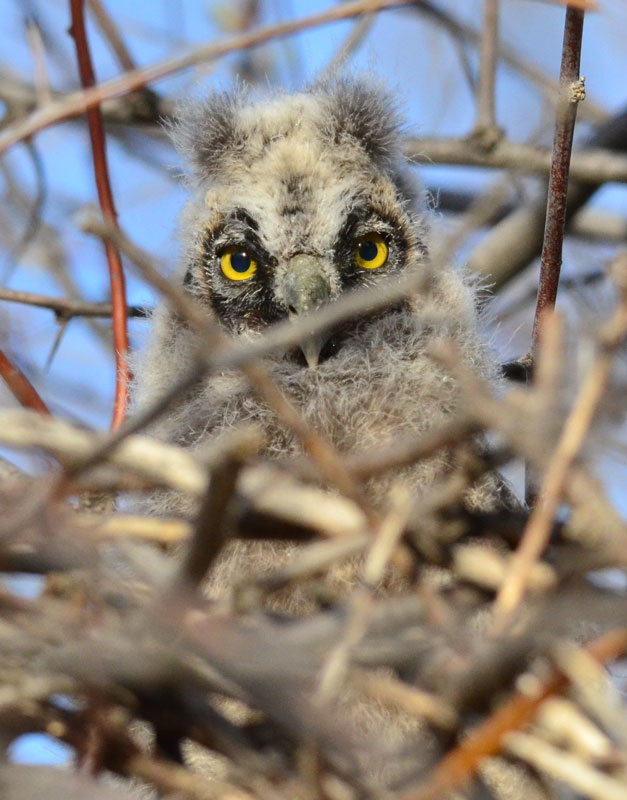SCHIESS: The secretive life of the long-eared owl
Published at | Updated at
Hiking through a dense thicket at Mud Lake Wildlife Management Area, the clicking sound of a beak and the meowing like a cat stopped me dead in my tracks. I finally located two bright yellow eyes looking at me through the thick brush. Adjusting my position slowly, I could finally make out the long ears and facial discs of an adult Long-eared owl.
Another clicking sound above me startled me. Just six feet above my head in the center of a Russian olive bush were three owlets peering down at me. The nest was on top of an old magpie nest and I wondered if owls had had “pies” for dinner one day.
As I moved away from the nest to get a picture, both parents showed up, buzzing me, landing nearby faking injuries and then divebombing me as I moved further from the nest. The long ears were usually flattened against the heads and the snapping of the beaks told me I was a persona-non-grata and to move along. I did, locating a Great-horned owl nest and an adult Saw-whet owl.
Following these owls this spring has been an exciting activity for me that may never happen again as Long-eared owls are extremely nomadic. Their habits and existence depends on the up and down cycles of voles and other small rodents. Starvation is one of the main causes of mortality of these specialized hunters especially when there is a sudden drop in the rodent population like this past winter.

Here in southeastern Idaho two species of voles, the Prairie and the Marsh voles are used heavily by both the Long-eared and Short-eared owls. They will occasionally take other small rodents and a few young birds so the adult magpies were probably safe, but any young magpies may become a “pie” dinner.
Long-eared owls are very mysterious. Little is known about their population as their conservation status appears stable in North America at times and then they disappear. Their abundance follows the upward cycle of the availability of rodents.
Another problem with estimating their population is their nesting habits. Many will start nesting in February or March, while others start nesting as late as June or July. Nests are usually old magpie, crow or hawk nests and in the thickest of the brush. Yellow eyes peering over a pile of sticks are often the only way to identify an active nest.

The female will usually lay about five or six eggs and will incubate them for about 28 days. During incubation and the brooding of the young, the male brings in all the food for the female and the owlets. After the owlets are seven weeks old, the female abandons the nestlings, but the male will continue to feed them, teaching them to hunt for another two to three weeks. There is evidence that some females will find a willing fella’, slip off together and hatch another family before summer is over.
Unlike most owls that begin hunting at dusk, Long-eared owls wait until well after dark to begin hunting. This may be because two of their main enemies are Northern Harriers and Great-horned owls that hunt in the early evening. They will usually not hunt near the nest, but will work open meadows and fields a short distance away from the young. When disturbed during the day, they will fly close to the ground, darting between bushes with the only sound being their wings brushing the trees as they fly.
In the winter often Long-eared owls gather in groups of up to 15 birds. These groups are called a parliament or a legislature: sleeping all day and then hooting and carrying on all night long.
You want to see a Long-eared owl — search the thickest brush near a marsh or fields where rodents are abundant and you might get lucky enough to be clicked at.

Living the Wild Life is brought to you by The Healing Sanctuary.


